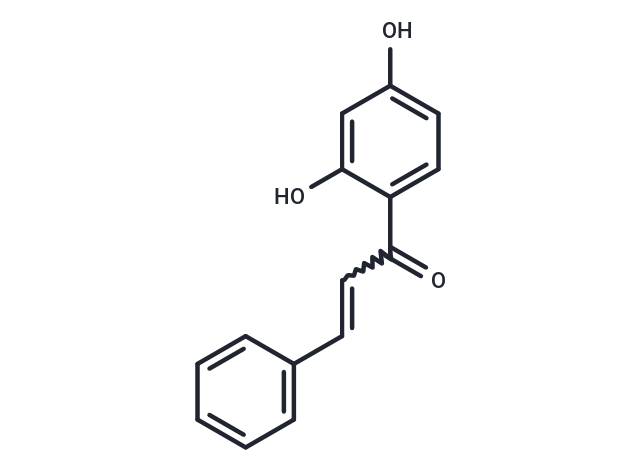Shopping Cart
- Remove All
 Your shopping cart is currently empty
Your shopping cart is currently empty

2',4'-DIHYDROXYCHALCONE (2',4'-DHC) as a compound with Hsp90 inhibitory and antifungal effects

| Pack Size | Price | Availability | Quantity |
|---|---|---|---|
| 2 mg | $50 | In Stock | |
| 5 mg | $72 | In Stock | |
| 10 mg | $101 | In Stock | |
| 25 mg | $183 | In Stock | |
| 50 mg | $275 | In Stock | |
| 100 mg | $414 | In Stock | |
| 1 mL x 10 mM (in DMSO) | $77 | In Stock |
| Description | 2',4'-DIHYDROXYCHALCONE (2',4'-DHC) as a compound with Hsp90 inhibitory and antifungal effects |
| In vitro | In the presence of 2',4'-DHC (8 g/mL), radial growth of Aspergillus fumigatus was inhibited 20% compared to the control, and green pigmentation was completely blocked.?The expression of the conidiation-associated genes abaA, brlA, and wetA was significantly decreased (approximately 3- to 5-fold) by treatment with 2',4'-DHC.?The expression of calcineurin signaling components, cnaA and crzA, was also significantly reduced.?The inhibitory effects of 2',4'-DHC on metabolic activity and mycelial growth were significantly enhanced by combination treatment with itraconazole and caspofungin.?Docking studies indicated that 2',4'-DHC bind to the ATPase domain of Hsp90.?2',4'-DHC act as an Hsp90-calcinurin pathway inhibitor[1]. |
| Alias | 2',4'-DHC |
| Molecular Weight | 240.25 |
| Formula | C15H12O3 |
| Cas No. | 1776-30-3 |
| Smiles | Oc1ccc(C(=O)C=Cc2ccccc2)c(O)c1 |
| Relative Density. | 1.286g/cm3 |
| Storage | Powder: -20°C for 3 years | In solvent: -80°C for 1 year | Shipping with blue ice. | |||||||||||||||||||||||||
| Solubility Information | DMSO: 11 mg/mL (45.78 mM) | |||||||||||||||||||||||||
Solution Preparation Table | ||||||||||||||||||||||||||
DMSO
| ||||||||||||||||||||||||||

Copyright © 2015-2024 TargetMol Chemicals Inc. All Rights Reserved.